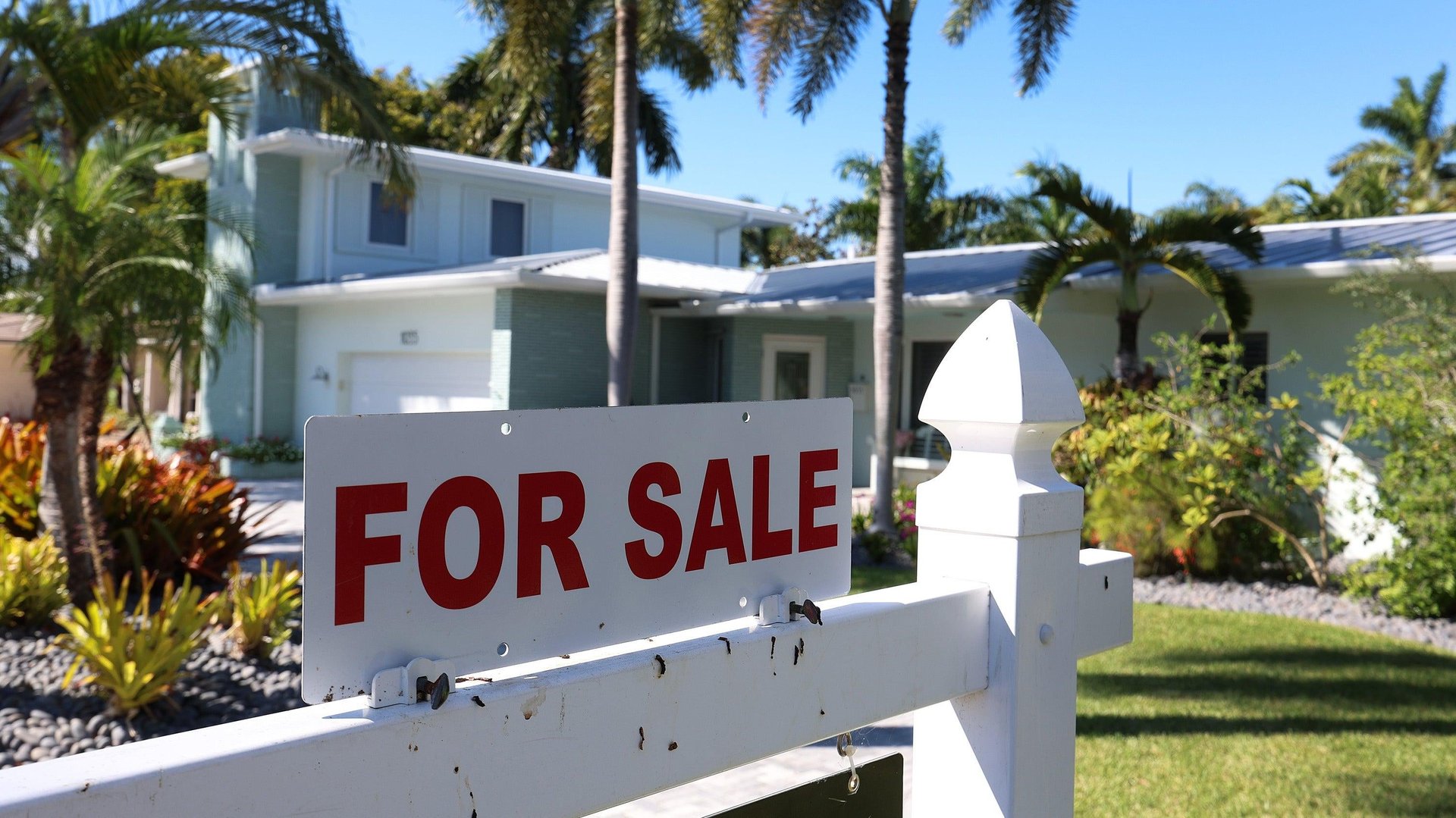The value of US homes recorded its biggest six-month drop since 2008
The Bay Area saw the biggest fall, but the market is hot in flood-prone Florida

US homes have recorded the largest fall in value since the global financial crisis.
Suggested Reading
In June 2022, US homes were worth a record $47.7 trillion. By the end of the year, they fell by almost 5% to $45.3 trillion. That’s the largest June-to-December drop in percentage terms since 2008, according to an analysis of real estate brokerage Redfin of more than 99 million US residential properties.
Related Content
In those six months, homebuyer demand has waned, largely due to rising mortgage rates driven by successive Federal Reserve interest rate hikes, which made buying a home more expensive. As such, the housing market has shed value—especially in pricier metros and tech hubs.
Changes in US home prices, by the digits
$383,249: Median US home sale price in January 2023, down 11.5% from a peak of $433,133 in May, and up just 1.5% from January 2022.
6.36%: Average 30-year fixed mortgage rate in December, down from the 20-year peak of 7.08% in November but still roughly double the level at the start of 2022.
$13 trillion: How much higher the total value of US homes is compared to February 2020, the month before the coronavirus outbreak
Charted: Bay Area’s housing market took the biggest hit
Why did prices plummet in pricey coastal tech hubs?
🏷 In already expensive markets, home values had more room to fall.
🏘 An exodus of residents during the pandemic saw people moving away from major cities, citing social distancing and remote work—“prioritizing space and affordability over proximity to the workplace,” according to Redfin.
💼 Tech layoffs and a worsening stock market contributed to relocation.
Quotable: The Bay Area effect on Asian-American homeownership
“One reason Asian homeowners may be losing more value than other homeowners is that many of them live on the West Coast, which has seen a relatively large dropoff in home value,” —Redfin economics research lead Chen Zhao. (Redfin’s research shows the total value of homes in predominantly Asian neighborhoods fell 0.7% whereas majority Black, white, and hispanic neighborhoods saw gains of nearly 6%, 7%, and 8% respectively.)
Florida: The Sunshine State with brighter prospects
In Miami, Florida, the total value of homes in Miami rose almost 20% year over year to $468.5 billion in December—the largest annual increase in percentage terms among the metros Redfin analyzed.
And it wasn’t an anomaly. In the same state, the cumulative value of homes in North Port-Sarasota and Lakeland also grew nearly 18% and 17% respectively. In fact, Florida was home to six of the 10 metros with the largest annual home-value gains, in percentage terms—even after Hurricane Ian wreaked havoc in September.
“People are pouring in from New Jersey and New York, in large part because Florida has relatively affordable homes and no income tax,” said Elena Fleck, a Redfin real estate agent in Palm Beach, Florida. “They can get a lot more bang for their buck here.”
The high risk of both flooding and heat doesn’t seem to bother those migrating.
Climate change is the last thing on home buyers’ minds
Home values in places that face high risk from climate change, be it heat, storm, flooding, or wildfires, have performed “roughly the same or better” as home values in places that exhibit a low probability of these risks. Other factors—affordability, proximity to family and/or access to the outdoors—seem to take precedence.
Drought was the only natural disaster for which home values climbed more in low-risk places than in high-risk places.
One more thing: The Biden-Harris administration’s attempt to make home ownership more attainable
Amid the nationwide housing supply shortage, home financing costs have skyrocketed over the past year. Mortgage rates have doubled during the period. First-time buyers who don’t have the ability to put down a 10% down payment or who struggle with a not-so-stellar credit score are especially disadvantaged.
The Department of Housing and Urban Development (HUD), through the Federal Housing Administration (FHA) meant to target such disadvantaged buyers, is reducing the annual mortgage insurance premium—the monthly fee that homeowners with FHA-insured mortgages pay to insure their mortgages, which is charged on top of their monthly principal and interest payments.
The fee is being dropped by 0.3 percentage points, from 0.85% to 0.55%, for most new borrowers starting March 20, the White House announced yesterday (Feb. 22). It’s poised to save more than 850,000 homebuyers—primarily low- and middle-income and first-time buyers—an average of $800 annually
The impact won’t be far-reaching, considering FHA-insured mortgages are just a single-digit share of all home sales. However, among the FHA borrowers who stand to benefit, more than 80% are first-time buyers—a group that’s getting smaller in size and older in age—and more than 25% are homebuyers of color, who typically find it difficult to get on the property ladder.
The Biden administration is able to finance the recalibration of premiums because the HUD has accumulated reserves at a level that is more than five times the required threshold set by Congress, courtesy a combination of “responsible and responsive management policies, home price appreciation, and significant refinance volume,” the White House said.
Related stories
🏠 US housing in 2023 won’t be a buyer’s market or a seller’s market
